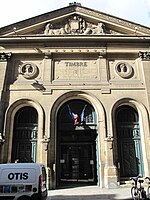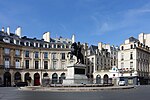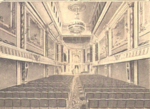Caserne des Petits-Pères
2nd arrondissement of ParisFrench building and structure stubsUnits and formations of the French Gendarmerie

The Caserne des Petits-Pères (lit. 'barracks of the Little Fathers'), also known as Caserne de la Banque, is a barracks building at 12, rue de la Banque in Paris. It was erected for the garde nationale de Paris and has been used lately by the Republican Guard. Like the nearby Place des Petits-Pères, it takes its name from the former convent of discalced Augustinians (known colloquially as the "little fathers") on whose grounds the rue de la Banque was opened in the 1840s.
Excerpt from the Wikipedia article Caserne des Petits-Pères (License: CC BY-SA 3.0, Authors, Images).Caserne des Petits-Pères
Rue de la Banque, Paris 2nd Arrondissement (Paris)
Geographical coordinates (GPS) Address Nearby Places Show on map
Geographical coordinates (GPS)
| Latitude | Longitude |
|---|---|
| N 48.86724 ° | E 2.34074 ° |
Address
Rue de la Banque 12
75002 Paris, 2nd Arrondissement (Paris)
Ile-de-France, France
Open on Google Maps











